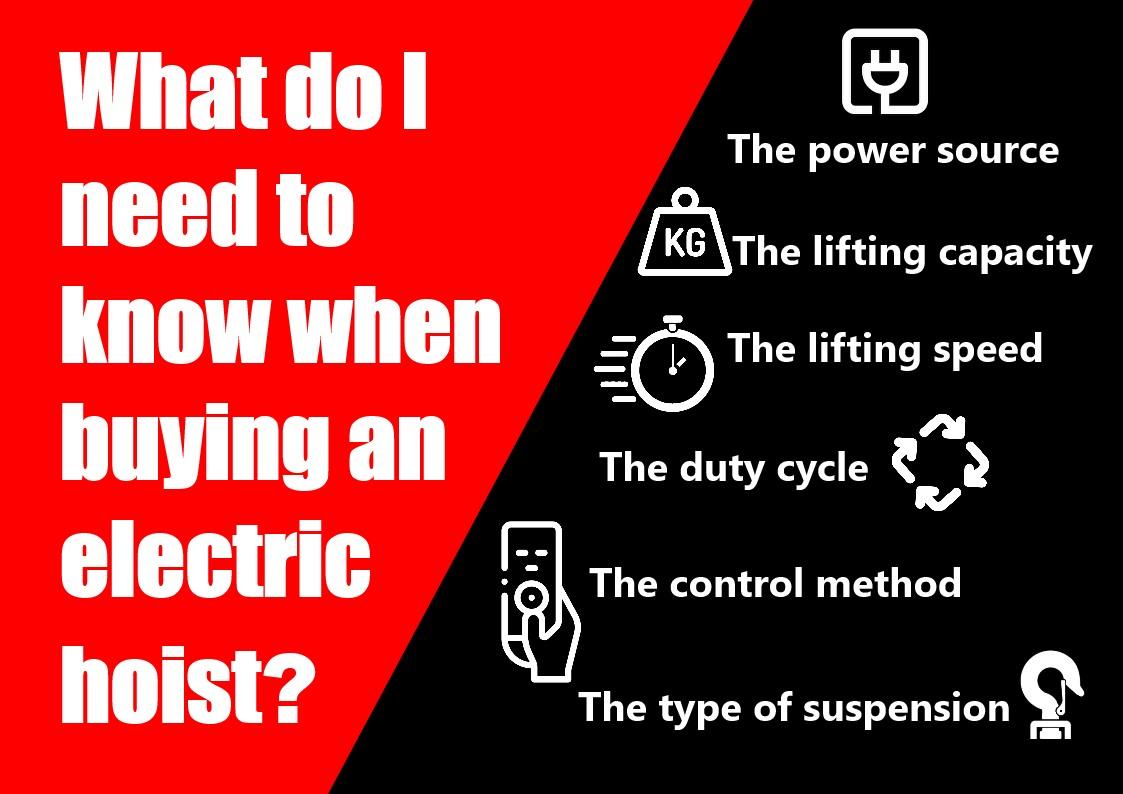When buying an electric hoist, there are several factors to consider before making a purchase. Electric hoists are devices that use electric motors to easily lift and lower heavy loads. They are commonly used in industrial, construction, and automotive applications.
To see our extensive range of electric hoists, please CLICK HERE
Some of the factors to consider when buying an electric hoist are:
-The power source:
This is the type of electricity that the hoist uses to operate. It can be either single-phase 110V/240V or three-phase 400/440V, depending on the voltage and frequency of the supply. 110V is recommended for construction sites. 240V Single-phase power is typically available in residential and commercial settings, while 400/440V three-phase power is more common in industrial settings. The difference between single-phase and three-phase power is that single-phase power has one alternating current (AC) waveform, while three-phase power has three AC waveforms that are offset by 120 degrees. This means that three-phase power can deliver more power and efficiency than single-phase power, but it also requires more complex wiring and equipment. You should choose a hoist that is compatible with your power source or use a transformer or converter if needed.
The lifting capacity:
This is the maximum weight that the hoist can handle safely. Choosing a hoist that can meet your lifting needs without exceeding its capacity is important. You should also factor in the weight of the sling, grab, and other accessories that may be attached to the load.
The lifting speed:
This is the rate at which the hoist can raise or lower the load. It is measured in feet per minute (fpm) or metres per minute (mpm). The lifting speed depends on the power of the motor, the size of the drum, and the diameter of the wire rope or chain. The speed of lift varies from 2 mpm up to around 12 mpm.
Considering the safety and efficiency aspects, you should choose a hoist that can offer a suitable lifting speed for your application. Dual lifting speeds are available; typically, the low speed is half the main speed. Variable speed hoists have continuous speed control, which features soft start, rapid acceleration, and soft stop to optimise load-handling operations. An extended speed range system allows the hoist to run at faster speeds with lighter or no loads to increase productivity.
The duty cycle:
This is the percentage of time that the hoist can operate continuously without overheating or damaging its components. It is expressed as a ratio of 25% or 50% on and off time. The duty cycle depends on the frequency and duration of use; the height of the lift (HOL), i.e. the distance between the suspension point and the floor level, is a very important factor, as the higher the lift, the longer the operating time, then the ambient temperature, and the cooling system of the hoist. You should choose a hoist that can match your duty cycle requirements or opt for a higher-rated hoist if you expect frequent or prolonged use.
The control method:
This is how you operate the hoist, manually or remotely. Manual control involves using a push-button pendant to control the movement of the hoist. Remote control involves using a wireless device such as a radio or infrared transmitter to control the hoist from a distance. You should choose a control method that suits your preference and convenience, as well as the safety and accessibility of your work area.
Types of suspension:
For electric chain hoists:
Fixed suspension - With eyebolt or hook suspension
Hand-push trolley - Horizontal movement by pushing/pulling the load. Recommended for light duty and short load travel only. The push trolley is adjustable for variable flange widths, fitted with steel machined wheels, permanently self-lubricated bearings, and anti-tilt derailment bars and can be equipped with shock-absorbing buffers.
Electric trolley - Movement operated by the push button panel fitted on the hoist. Recommended when manual load pushing is not feasible and for heavy-duty use. The electric trolley is adjustable for variable flange widths, fitted with steel machined wheels, permanently self-lubricated bearings, fitted with anti-tilt derailment bars to prevent drop or derailing and equipped with shock-absorbing buffers. The trolley can be supplied with 1 or 2 speeds. Options for Electric limit switches to limit the horizontal travel of the electric trolley on the beam.
Low headroom execution. The best solution to get the maximum hook run is to fit on a frame with a return system for the chain. The frame is often mounted on two trolleys. Available in electric or hand-push execution.
Climbing execution. Allows the reaching of the installation point with the hook and the related chain without having to lift the entire weight of the hoist. It is particularly suited to the entertainment industry and when frequent installation and dismantling at greater heights are requested.
Suspension for electric wire rope hoists:
Fixed configuration – frame-mounted for a suspended execution.
Normal headroom monorail trolley - The hoist is suspended and assembled to the trolley that runs on the lower flange of the beam. The trolley is also available as an articulated version to run on curves.
Low headroom monorail trolley - The hoist is suspended on the trolley that runs on the lower flange of the beam. Supporting bars with circular cross sections which support the hoist in a set position. Counterbalance on a supporting bar to balance the eccentric weight of the hoist.
Double girder trolley for OET cranes. Electric double girder trolleys travel on top of rails fitted on the crane beams; this allows the maximum hook path. The hoist can be fitted on the top of the trolley or suspended it can also be fitted in a transversal position with respect to the crane's beams.
-----------------------------------------------------------------------------------------------------------------------------------

